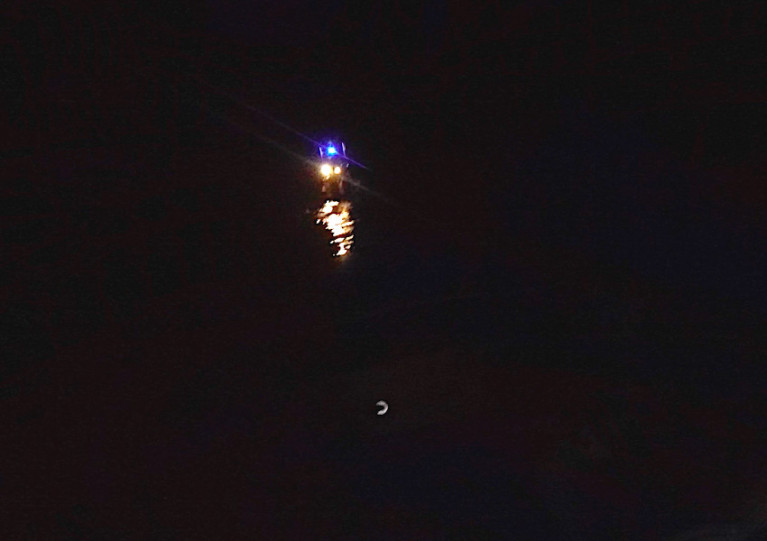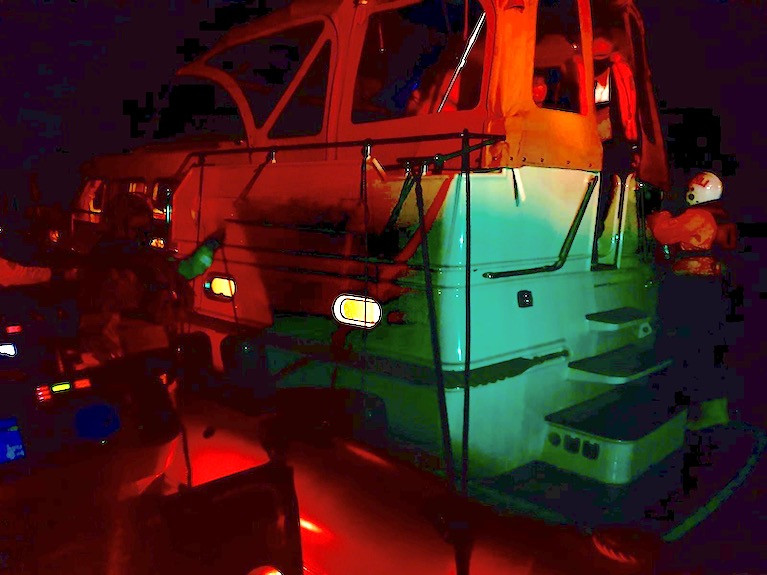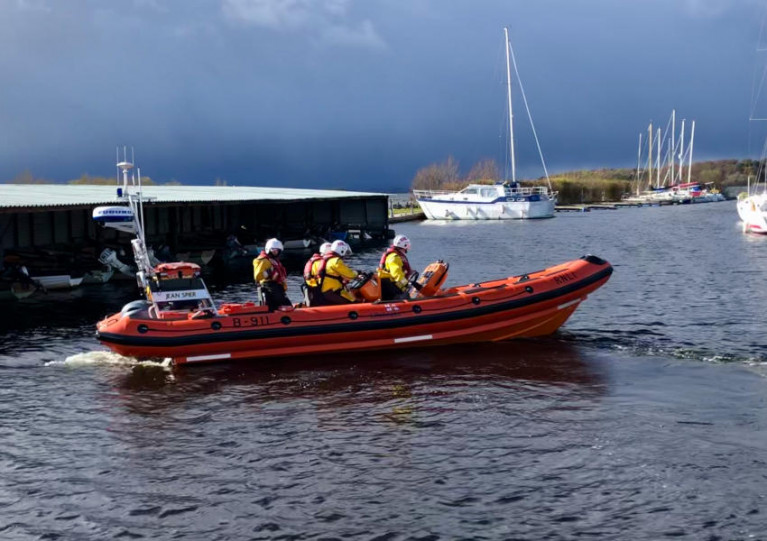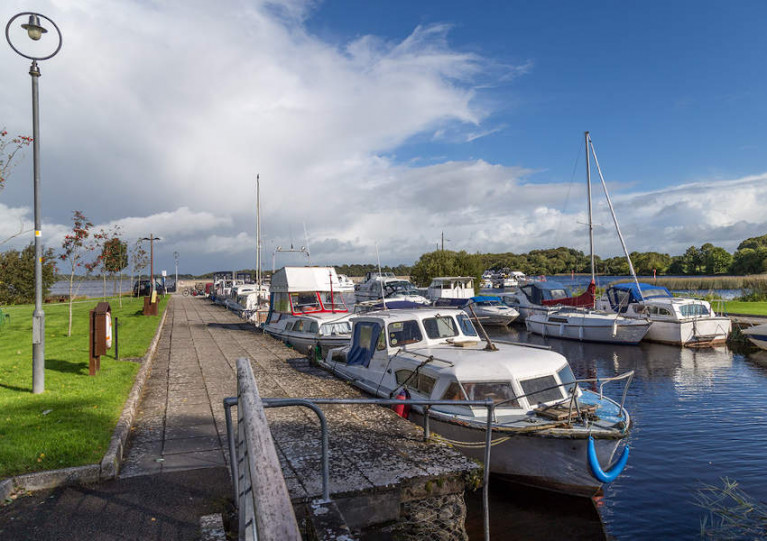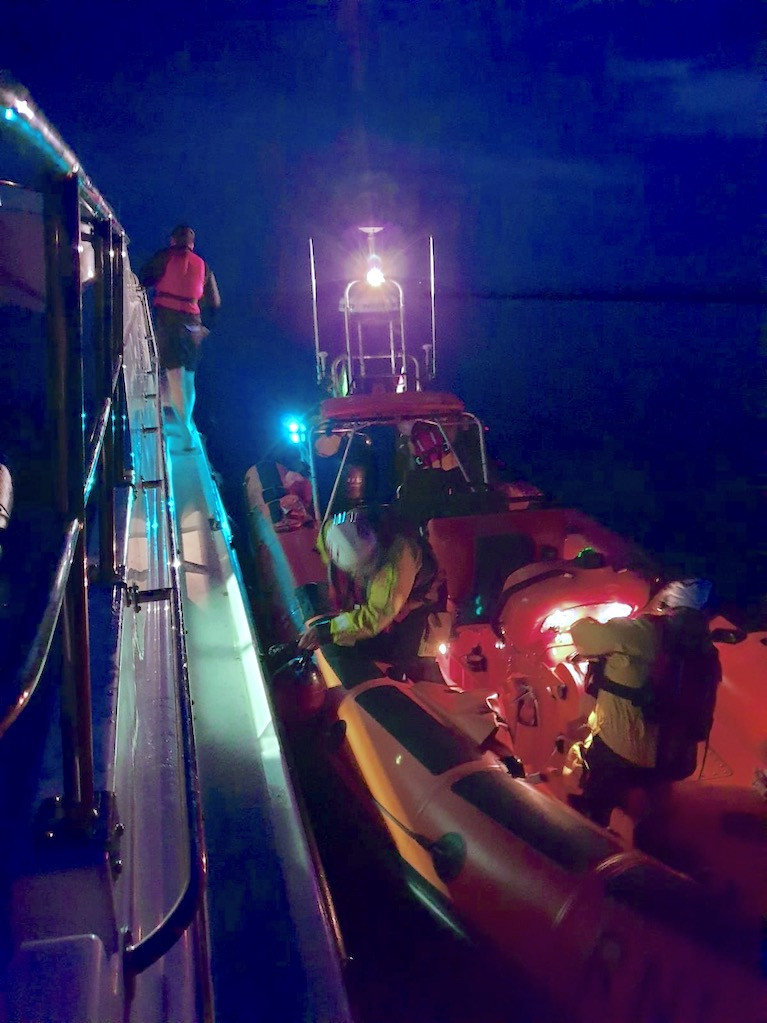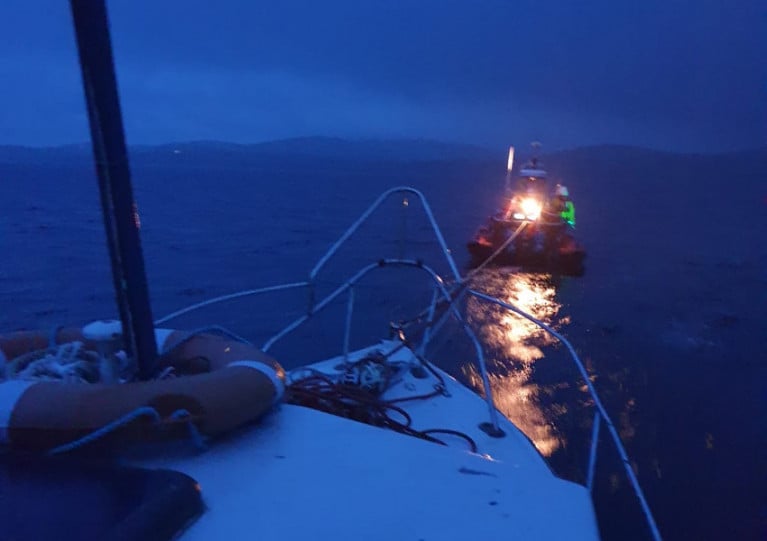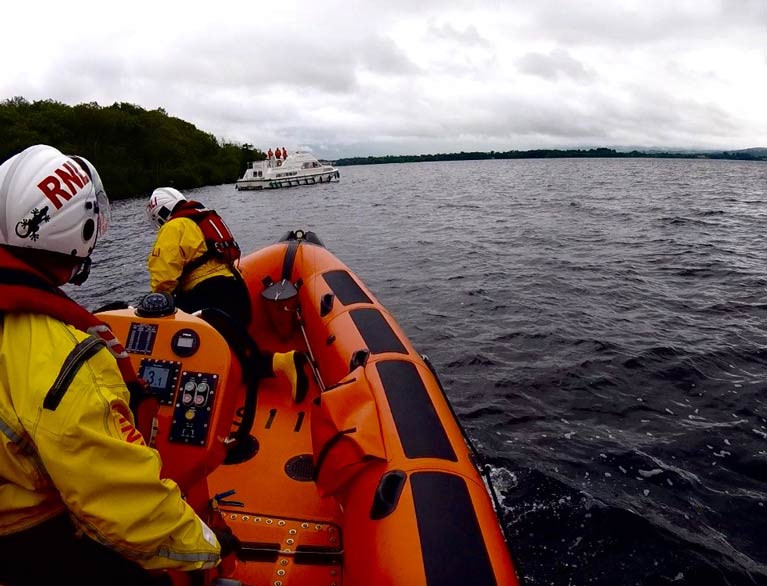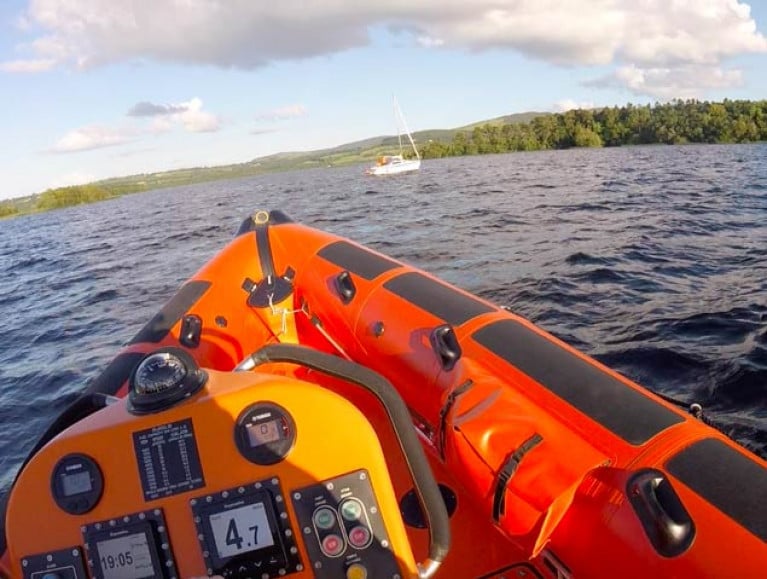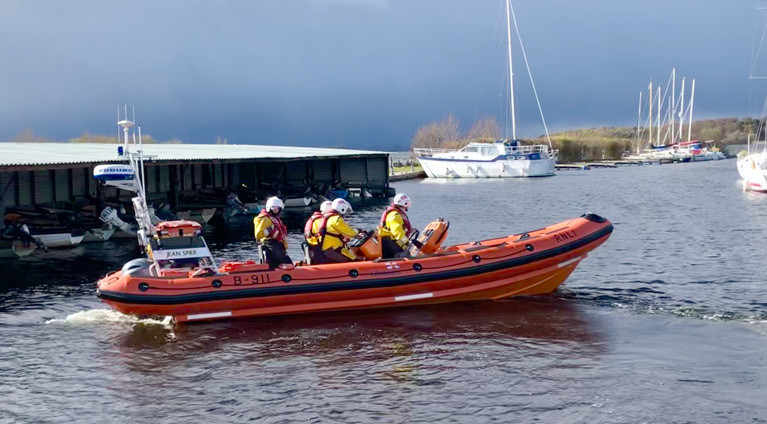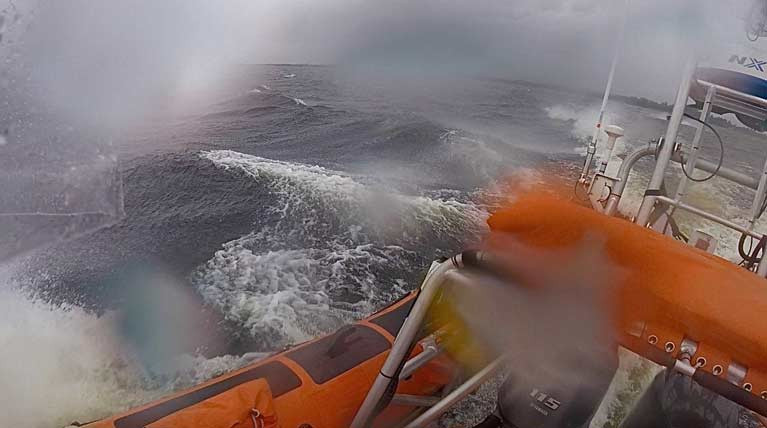Displaying items by tag: Lough Derg
Lough Derg Lifeboat Launches To Cruiser Adrift In Reeds
A busy week for Lough Derg RNLI’s lifeboat volunteers continued on Tuesday night (8 September) after a 20ft cruiser suffered engine failure at the lough’s northeastern end.
The lifeboat Jean Spicer launched just before 9.20pm and used all onboard electronic navigation aids to locate cruiser, which was adrift by Bellevue Point.
On request, the three people on board the cruiser flashed a light for the lifeboat crew as they approached, and great care was taken to bring the lifeboat alongside the casualty vessel which had drifted into reeds close to the shore.
All on board were dafe and unharmed, and the motorboat was brought under tow to Dromineer Harbour.
Deputy launching authority Peter Kennedy advises boat users to “make sure your engines are fully serviced, and that you have sufficient fuel for your journey.
“Always carry enough lifejackets for everyone on board and that they are worn.”
The callout marked the third to a cruiser in difficulty in as many days for the Lough Derg crew — following a 35ft cruiser aground by the Silver Islands on Monday evening (7 September) and a vessel with engine failure near Mountshannon Harbour on Sunday (6 September).
Lough Derg RNLI Assist 35ft-Cruiser Aground By the Silver Islands on Galway Shore
At 8.25 pm this evening, Monday, September 7, Valentia Coast Guard requested Lough Derg RNLI lifeboat Jean Spier to assist 4 people on a 35ft cruiser reported to be aground near Terryglass Bay.
At 8.47 pm the lifeboat launched with helm Eleanor Hooker and crew Owen Cavanagh, Keith Brennan and Chris Parker on board. It was nightfall, so the crew used their onboard electronic navigation, RADAR, searchlights, night vision binoculars and local knowledge as adjuncts to navigation. Winds were southwesterly, Force 4 gusting 5.
As the lifeboat approached Terryglass Bay, volunteer crew could see a flashing light signal ahead. Valentia Coast Guard provided the lifeboat crew with a contact telephone number for the casualty vessel.
The casualty vessel confirmed it was their boat emitting the light signal. To determine the aspect of the casualty vessel, the lifeboat crew asked from which direction the vessel had been travelling when it went aground, and whether they were looking at the lifeboat travelling in their direction from the bow or stern of their vessel.
The lifeboat made way to the red marker by Rinmaher Point on the Galway shore, and after rounding it, took soundings of the depth to the casualty vessel.
The lifeboat was alongside the casualty vessel at 9.06 pm. All four people on board were safe and unharmed and wearing their lifejackets. An RNLI volunteer transferred to the casualty vessel. Once he was satisfied that the vessel was not holed, he set up for a tow.
The lifeboat took the cruiser off the rocks and out into safe water where drives and rudder were checked and found to be in good working order.
With an RNLI volunteer remaining on the casualty vessel with her four passengers, the cruiser followed the lifeboat across the bay into Terryglass Harbour, the safest closest harbour, where it was safely tied alongside at 10.08 pm.
The lifeboat departed the scene and was back at station at 10.50 pm.
Christine O’Malley, Deputy Launching Authority at Lough Derg RNLI advises boat users to ‘study your charts and for your safety, plan your passage so that you arrive at your destination before nightfall’.
Lough Derg Lifeboat Launches To Cruiser With Engine Failure
Lough Derg RNLI volunteers were tasked to the aid of two people on a cruiser which engine failure near Mountshanon Harbour yesterday afternoon, Sunday 6 September.
The inshore lifeboat Jean Spicer diverted from a training exercise just before 2pm and made way to the reported location.
With no vessel in sight, the lifeboat crew made radio contact with the stricken vessel, which it turned out had drifted close to rocks east of the Scilly Isles.
The two on board the 27ft cruiser were safe and unharmed, and wearing lifejackets.
A lifeboat crew member was put aboard and discerned that the cruiser has suffered a gearbox failure.
A tow was then set up to bring the broken down vessel back to Mountshannon Harbour, and within an hour the lifeboat had returned to Dromineer Bay to complete its exercise.
‘Even on the calmest days, inflatable toys are not fit for the conditions you will experience along our coastline’
Elsewhere on Sunday afternoon, Arklow RNLI’s all-weather lifeboat Ger Tigchlearr launched to reports of a person in difficulty in a small inflatable boat off Mizen Head.
Once the crew was on scene, the individual tried to make his way back to shore while the lifeboat stood by.
But the rocky coastline and prevailing tidal conditions made this difficult, so it was agreed the safest option was to take the person on board the lifeboat.
Following the incident, Arklow RNLI’s community safety officer Mark Corcoran said: “Thankfully this afternoon was relatively calm, had conditions been worse the situation might not have ended so well.
“In recent weeks there has been a lot of rescues all around our coastline of people from small inflatable boats and toys.
“We’d like to remind people of the real risk of drowning when you go to sea on vessels of this nature, even on the calmest days these types of boats and toys are not fit for the conditions you will experience along our coastline.”
Claims of speeding RIBs and jet skis over the weekend have prompted a call for a no-wake notice for Terryglass Harbour on Lough Derg.
One boater said the powered vessels caused “large wakes in very close proximity to moored cruisers on the concrete jetty, causing sustained and substantial discomfort for these boats and their crews throughout the weekend”.
No wake zones have been established elsewhere on Ireland’s inland waterways, most recently at Newferry on the Lower Bann were vessels must proceed at a slow speed when passing the jetties and slipways.
Lough Derg RNLI Assist Eight People on Cruiser Aground
At 9.28 pm last night, Thursday, August 13, Valentia Coast Guard requested Lough Derg RNLI to go to the assistance of 8 adults on a 45ft cruiser aground by Ryan’s Point, inside the Mountaineer Bouy at Barrack Bay.
At 9.42 pm the RNLI lifeboat Jean Spier launched with helm Eleanor Hooker, and crew members Owen Cavanagh, Keith Brennan and Doireann Kennedy on board. The wind was northeasterly, Force 2. It was nightfall with poor visibility; the RNLI volunteers used on-board electronic navigation, RADAR, searchlights and local knowledge to steer their course to the casualty.
Once the lifeboat rounded the Mountaineer Buoy, the crew took soundings of the depths in a cautious approach to the casualty vessel. The lifeboat came alongside at 9.55 pm and found all eight people to be safe and unharmed and wearing their lifejackets.
An RNLI volunteer transferred to the cruiser. Once he was satisfied that the vessel was not holed, he set up for a tow. The lifeboat attempted to take the casualty vessel astern off the rocky shelf. However, it was stuck fast on the rocks.
As the cruiser had been travelling in company, and its companion vessel was moored in Garrykennedy Harbour, the lifeboat informed Valentia Coast Guard of its intention to take all passengers on to the lifeboat and to bring them to Garrykennedy Harbour for the night.
Valentia Coast Guard arranged for the casualty vessel to be attended to first thing the following morning.
At 11.04 pm the lifeboat delivered the eight people into to the care of their friends at Garrykennedy Harbour.
The lifeboat departed the scene and was back at Station at 11.30 pm
Peter Kennedy, Deputy Launching Authority at Lough Derg RNLI advises boat users to ‘study your charts and plan your passage, paying close attention to the navigation buoys’.
Lough Derg RNLI launched last night (Thursday 6 August) to the aid of four people on a 23ft cruiser aground on rocks in Scarriff Bay.
The lifeboat Jean Spier launched at 9.20pm, in fading light with a low mist and heavy rain squalls, to the scene behind Holy Island at the south-western end of the lough.
Valentia Coast Guard also requested the Shannon-based Irish Coast Guard helicopter Rescue 115 to assist.
As the lifeboat passed Holy Island, its crew spotted an SOS light signal from the shore, in an area known as the Black Rocks.
The lifeboat navigated with caution to the casualty vessel, which had dropped anchor nearby but the anchor dragged and saw the boat pushed into a dangerous and rocky area of shore.
The two adults and two teenagers on board were found safe and unharmed, and wearing their lifejackets.
An RNLI volunteer transferred to the casualty vessel and, after checking for damage, set up for a tow to bring the vessel off the rocks and back out to safe water.
The lifeboat then took the casualty vessel to Mountshannon Harbour, making slow progress in the poor weather with reduced visibility and eventually arriving just after 10.30pm.
With the harbour at capacity, the skipper of a moored vessel offered to have the casualty boat rafted next to theirs for the night.
Keith Brennan, trainee helm at Lough Derg RNLI, commended the quick actions of the skipper on the casualty vessel.
“He did everything correctly: deploying the anchor once his engine failed, calling for help and using light signals to indicate his position to the lifeboat.”
Lough Derg RNLI Assist Motor Cruiser Aground
Valentia Coast Guard requested Lough Derg RNLI to go to the assistance of six people on a 42ft motor cruiser that ran aground at the southern end of the Corakeen Islands, in Dromineer Bay yesterday afternoon. The wind was westerly, Force 3. Visibility was good to fair, with frequent heavy rain squalls.
At 3.20 pm the RNLI lifeboat Jean Spier launched with helm Eleanor Hooker, and crew members Ger Egan, Keith Brennan and Chris Parker on board.
Using navigation charts and taking depth soundings, the lifeboat made a careful approach to the cruiser and was alongside the casualty vessel at 3.30 pm.
The lifeboat volunteers found all on board the cruiser to be safe and unharmed and wearing their lifejackets. An RNLI crew member was transferred to the casualty boat and once satisfied it was not holed, set up for a tow. At 3.40 pm the lifeboat had the casualty vessel off the rocks and towed out into safe water.
Once in safe water, and after it was established that the drives and the propeller were in good working order, the tow was released. With an RNLI volunteer remaining on board, and the lifeboat standing by, the cruiser made way to Dromineer Harbour. As both vessels approached Dromineer Harbour, the lifeboat went ahead to drop off two crew so that they could receive lines from the cruiser as she came alongside. At 4.35 pm the cruiser was safely tied alongside in the public harbour at Dromineer.
At 3.40 pm Lough Derg RNLI departed the scene to return to base.
Liam Maloney, Lifeboat Operations Manager Lough Derg RNLI advises boat users to ‘enjoy Lough Derg, plan your passage, keep a lookout for your next marker and remember to stay within the navigation channels’.
Lough Derg RNLI Assist 21ft Yacht Aground by Jushing Rocks
Lough Derg RNLI assisted 2 people on a 21ft yacht aground by Jushing Rocks, west of the Scilly Islands on the Ogonoloe shore in County Clare.
Earlier this evening, Sunday, July 19, Valentia Coast Guard requested Lough Derg RNLI to go to the assistance of two people on a 21ft yacht that ran aground by Jushing Rocks, west of the Scilly Islands on the Ogonoloe shore, County Clare. At 7.50 pm the RNLI lifeboat Jean Spier launched with helm Owen Cavanagh, and crew members Doireann Kennedy, Tom Hayes and Chris Parker on board. The wind was north-westerly, Force 2. Visibility was good.
The lifeboat arrived on scene at 8.02 pm. A passing yacht that had remained on scene in safe water, provided the lifeboat crew with details of the yacht in difficulty. The lifeboat used its navigation charts and took depth soundings as it neared the cruiser, and was alongside at 8.10 pm.
The lifeboat found both people to be safe and unharmed. An RNLI crew member was transferred to the casualty boat and, once satisfied the boat was not holed, set up for a tow. At 8.18 pm the lifeboat had the casualty vessel off the rocks and towed out into safe water.
The yacht’s engine was not working and as the casualty vessel’s home harbour was in Killaloe, following discussion with Valentia Coast Guard, Lough Derg RNLI passed the tow to the Killaloe Coast Guard unit who had arrived on scene.
At 8.37 pm Lough Derg RNLI departed the scene to return to base.
Owen Cavanagh, helm at Lough Derg RNLI advises boat users to ‘enjoy Lough Derg, plan your passage, study your charts and stay within the navigation channels’.
The lifeboat was refuelled and ready for service again at 9 pm.
Lough Derg RNLI assists a family of four on a 32ft cruiser that ran aground by Parker’s Point, on the Tipperary shore.
At 5.35 pm today, Wednesday, July 1, Valentia Coast Guard requested Lough Derg RNLI to go to the assistance of four people on a 32ft cruiser that ran aground by Parker’s Point, on the Tipperary shore. At 5.53 pm the lifeboat Jean Spier launched with helm Eleanor Hooker, and crew members Keith Brennan, Joe O’Donoghue and Doireann Kennedy on board. The wind was north-easterly, Force 3. Visibility was good.
Initially, there was some uncertainty regarding the casualty vessel’s location. The first report was that it was aground off Cribby Island, near Mountshannon on the County Clare shore. However, as the lifeboat approached the search area, the crew spotted a boat fitting the description of the casualty vessel close to the Tipperary shore, off Parker’s Point.
As the approach to the casualty vessel was particularly rocky, the lifeboat crew used navigation charts and depth soundings as it neared the cruiser, and was alongside at 6.10 pm. The four people on board, two adults, an infant and a child, were all safe and unharmed and wearing their lifejackets.
An RNLI crew member was transferred to the casualty boat and once he was satisfied the boat was not holed, set up for a tow. The lifeboat towed the vessel from the stern as rocks off the bow were visible above water.
Once in safe water and with the assistance of the RNLI crew member on board, the skipper made sure all drives and the propeller were in good working order.
The lifeboat accompanied the cruiser to Garrykennedy, the safest, closest harbour, where, at 7 pm, an RNLI volunteer helped to secure the boat safely alongside the quay.
Jeremy Freeman, Deputy Launching Authority at Lough Derg RNLI advises boat owners to ‘ensure you study your charts and remain within the navigation channels’.
The lifeboat returned to Station and was ready for service once more at 7.30 pm.
Lough Derg RNLI Lifeboat Launches In Severe Conditions for Motorboat with Engine Failure
Lough Derg RNLI lifeboat assisted two people on a 21ft motorboat suffering engine failure in severe weather conditions.
At 5.02 pm today, June 20, Valentia Coast Guard requested Lough Derg RNLI to go to the assistance of two people on a 21ft motorboat that had suffered engine failure near the Corakeens Islands. At 5.15 pm the lifeboat launched with volunteer helm Owen Cavanagh, volunteer crew Keith Brennan, Jimmy Gund Kjell and Joe O’Donoghue on board. The wind was southerly, Force 7 and gusting. Visibility was fair, with driving rain and frequent squalls.
A vessel in the vicinity had taken the motorboat under tow, but under the severe weather conditions, the vessel being towed was driven onto rocks by the entrance to Dromaan Harbour on the County Clare shore. The lifeboat arrived on scene at 5.20 pm. Once the RNLI volunteers established that the casualties were safe and unharmed, they took the motor vessel off the rocks and into Dromaan, the closest safe harbour, where it was tied alongside at 6.20 pm.
The two casualties, wearing face masks and gloves, were taken by the lifeboat back to Dromineer. The vessel that had provided assistance made its own way to the public harbour at Dromineer.
Owen Cavanagh, volunteer helm at Lough Derg RNLI advises boat owners to ‘ensure your engines are fully serviced and fuel is clean before returning to the water for the summer season’. He says ‘respect the water, and remember, always check the weather forecast before going afloat'.
The Lifeboat returned to station and was ready for service once more at 6.54pm


























